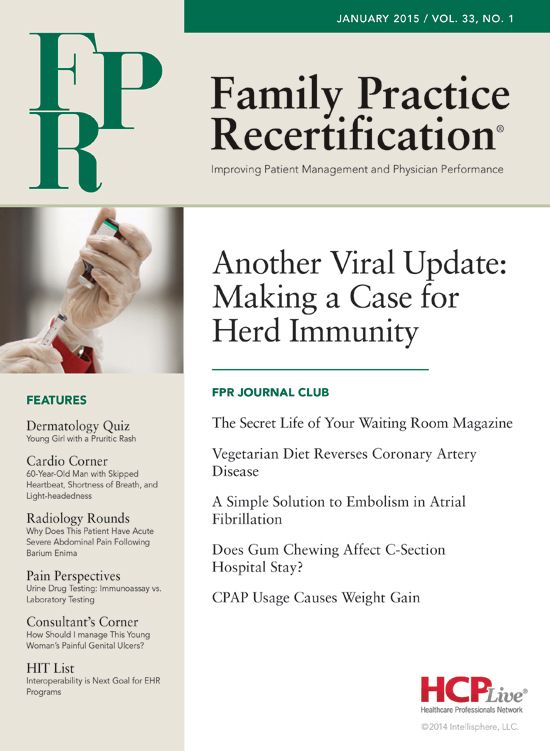Publication
Article
Family Practice Recertification
A Simple Solution to Embolism in Atrial Fibrillation
Author(s):
For patients with non-valvular atrial fibrillation, preventing stroke using anti-coagulation medication is the standard of care. This study looked at using a device that closes off the left atrial appendage of the heart to determine if it too would lower the risk of stroke.

Frank J. Domino, MD
Review
“A device that lowers the risk of stroke in patients with atrial fibrillation.” JAMA 2014; 312(19):1988-1998.
For patients with non-valvular atrial fibrillation (AF), preventing stroke using anti-coagulation medication is the standard of care. This study looked at using a device that closes off the left atrial appendage of the heart to determine if it too would lower the risk of stroke.
Study Methods:
This is a multi-centered randomized but un-blinded trial of over 700 patients with non-valvular atrial fibrillation and at least one other stroke risk factor. All patients had a CHADS2 score ≥ 1.
Patients were randomized to receive typical warfarin therapy to prevent stroke vs. receives a device that would fill the cavity of the left atrial appendage (LAA). Echocardiography studies demonstrated that the left atrial appendage is a major source of thromboembolism in patients with atrial fibrillation. Filling this space with a device that can exist there indefinitely will prevent thrombus formation in this space and thus lower the risk of stroke in patients with non-valvular atrial fibrillation.
This study enrolled over 700 patients meeting the inclusion criteria and randomized them to left atrial appendage closure device compared to warfarin treatment (INR target between 2-3). Outcomes were measured for the combined endpoint of stroke, systemic embolism, cardiovascular death, and all cause mortality.
Results & Outcomes:
At a mean follow-up of 3.8 years, 8.4% of LAA closure device patients reached the combined endpoint compared to 13.9% in the warfarin group (Rate Ratio = 0.06, 95% credible interval (CI), 0.14-1.05). Patients in the device group demonstrated lower rates of cardiovascular mortality, 1 event per 100 patient years (3.7%) vs. 2.4 events per 100 patient years in the warfarin group (9%); Hazard Ratio = 0.4; 95% CI = 0.21-0.75; p = 0.005. All cause mortality was also lower in the event group (12.3%) vs. in the warfarin group (18%); Hazard Ratio = 0.66; 95% CI = 0.45-0.98; p = 0.04.
Conclusion:
In patients with non-valvular atrial fibrillation at an elevated risk for stroke, percutaneous left atrial appendage closure with this device was both non-inferior and in fact superior to warfarin for preventing the combined outcomes of stroke, systemic embolism, cardiovascular death, as well as superior for both cardiovascular and all cause mortality.
Commentary:
Non-valvular atrial fibrillation’s main morbidity and mortality concern is its correlation with stroke risk. This is through a thromboembolic cause, which is believed to form in the left atrium.
The left atrial appendage is long believed to be the primary source of these thromboemboli. Closing this off using a percutaneously placed device has some risks. This study evaluates and compares those risks to the current standard of care, which includes long term anti-coagulation. This study solely evaluated warfarin and not any of the new novel anti-coagulant agents.
The safety of both interventions were evaluated and found to be similar. The most frequent adverse event in the device group was pericardial effusions. In the warfarin group and in the device group bleeding was also a risk. This latter adverse event is likely because once the left atrial device was implanted, patients were kept on an anti-coagulant regimen of aspirin or warfarin for 45 days to facilitate endothelial coverage of the device. This was followed by aspirin and clopidogrel, and after 6 months, aspirin mono-therapy alone.
Although use of the device had early complications as opposed to warfarin (which had much later complications) the overall rate of adverse events made the device at least as safe, if not safer than warfarin.
Some limitations of this study include the patient population, which had not been exposed to any anti-coagulant before. The demographics also demonstrated that more than 90% of the patients enrolled in the study were white so its applicability to other ethnic groups is unclear.
Although 3.8 years seems like a relatively short time, it is actually longer than most contemporary stroke prophylaxis trials. Over the 3.8 years there were a large number of voluntary withdrawals, especially in the warfarin group (just over 20%). The main reason for withdrawal from warfarin was a desire for alternative treatments, such as one of the new novel anti-coagulant therapies.
The mortality data of this study is impressive. The risk for death from a cardiovascular cause was significantly less in the device group compared to the warfarin group. The all cause mortality data difference also supports the device, making the prospect of an interventional treatment for the prevention on stroke in a non-valvular atrial fibrillation a likely future standard of care.
Complicating this potential practice change was the fact that there are no studies comparing this device to any of the new novel anti-coagulants currently available. Pending these trials the advent of left atrial appendage closure delivered by a catheter may soon be a commonly provided procedure that will be both helpful to our patients and provide them with a greater quality of life and lower risk.
About the Author
Frank J. Domino, MD, is Professor and Pre-Doctoral Education Director for the Department of Family Medicine and Community Health at the University of Massachusetts Medical School in Worcester, MA. Domino is Editor-in-Chief of the 5-Minute Clinical Consult series (Lippincott Williams & Wilkins).
Additionally, he is Co-Author and Editor of the Epocrates LAB database, and author and editor to the MedPearls smartphone app. He presents nationally for the American Academy of Family Medicine and serves as the Family Physician Representative to the Harvard Medical School’s Continuing Education Committee.






